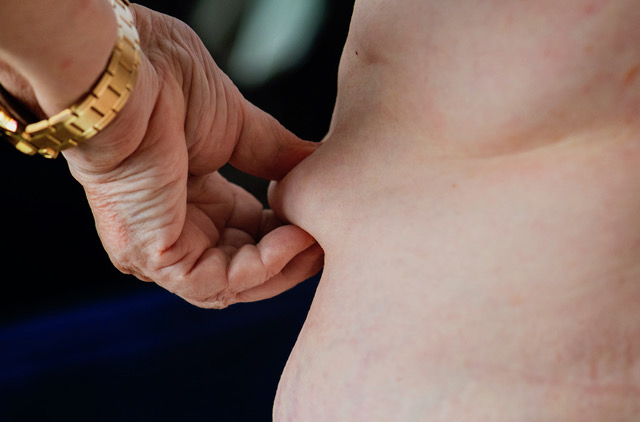
Obesity is primarily a lifestyle condition that has multiple causes, the majority of which can be summed up in some combination of genetics (less of a factor) and environment (epigenetics).
The health care industry uses a simple evaluation called body mass index (BMI) to diagnose overweight and obesity. The body mass index is a height-to-weight calculation. A person is considered overweight when their BMI is between 25-29.9 and obese if they have a BMI of 30 or higher. (If you’d like to calculate your own BMI, there are lots of simple online calculators. Just google “BMI calculator” and then enter in your height and weight.)
However, it is important to note that the BMI outcome does not account for body composition. For example, an athlete with a lower body-fat percentage and lots of muscle mass may have a BMI that puts them in the overweight or obese category when of course they are not overweight at all.
It’s important to establish a couple of presuppositions regarding obesity in general:
- Fat is not bad. It is critical for life. It has a good purpose in the body, specifically in the brain and nervous system, and it protects the body from physical trauma and extreme temperatures. Too much fat or too much in the wrong areas does, however, cause many health problems.
- Obesity is a serious health challenge even if the person who is obese doesn’t feel any major symptoms in the moment. It increases visceral fat, inflammatory response and eventually also increases inflammation in the liver and other areas.1 Obesity is a main risk factor for countless forms of morbidity and mortality and is associated not only with diabetes and cardiovascular disease, but also with cancer, liver and kidney disease and depression (and more).2 Although major weight loss is usually needed for optimal health, even small reductions in weight and modest lifestyle improvements can prove helpful.3 Obesity can shorten a person’s life by up to 14 years.4
Difference in fats: What is white adipose tissue (WAT) and how does it differ from brown adipose tissue (BAT)?
Adipose (fat) tissue is mainly made up of two types of fat: brown and white. And believe it or not, some fat is healthier than others.
White fat (WAT), sometimes referred to as “bad fat”, is fat storage. WAT is made of a huge fat droplet, which takes up about 90% of the adipocyte (fat cell).1 Most of the standard American diet (full of animal products and processed foods) will primarily become white fat. White fat is what causes obesity. WAT acts as part of the endocrine system in that it secretes lots of hormones and cytokines that regulate metabolism and inflammation in the body.1 This is one of the reasons that increased weight often brings with it an increase in hormone imbalances … the fat tissue actually acts as part of the hormone system.
There’s also brown fat, sometimes referred to as BAT (brown adipose tissue). Babies are born with a good amount of brown fat (about 5% of their bodyweight). It is important for keeping them warm as brown fat produces heat without shivering. This is key as newborn babies don’t have the musculature development yet to shiver (so they’d otherwise struggle to stay warm enough even with very slight temperature changes). BAT is typically found around the neck, upper back, shoulders and upper chest area.5
Until a few years ago, it was thought that only babies had brown fat but more research has shown that adults have it as well, although they normally have much less of it as it decreases with age under most circumstances. Brown fat can be seen (tested) via PET scans, which can confirm how much and the locations of a person’s brown fat as well as how active it is. An adult could have 50-200 grams of this metabolically active brown fat.6 This is a good thing…
Higher brown fat levels tend to occur in those with balanced blood sugar levels, otherwise lean people and women.6 That said, striving to increase your BAT is associated with those things.
Here’s where this gets interesting… Brown fat acts more like muscle than fat, in that it actually burns energy (calories) instead of storing it.
Brown fat increases energy expenditure (aka burns more calories), improves carbohydrate and fat metabolism as well as combats inflammation.1 It is made of many smaller fat droplets and is more highly vascularized (more blood vessels).1 BAT has far more mitochondria than WAT, which may be the reason that there is less of an inflammatory and macrophage (immune) response.1
Good news regarding fat:
White fat can actually be converted into brown fat. Brown fat cells also secrete hormones but not the same ones as WAT. They have special hormones specific to BAT that are released into the blood stream where they find WAT and help to convert it to BAT!6 This means that the harmful storage fat can become advantageous, which is especially great news for those who are obese or overweight.
How can you increase BAT to reduce body fat?
It’s important to note that the follow recommendations are assuming that there is a basic foundation for health. The health care industry as a whole has a tendency to focus on some specific, complicated, technical, hard-to-discover tactic, while forgetting that most people could be helped a great deal with basics like drinking adequate pure water, eating more fiber and getting good sleep, nutrition and clean air to breath (just to name a few). It is upon this foundation that we can talk about some of the following strategies. It’s not to say that these will only help if you’re doing all of the above; rather we’re promoting a truly holistic health lifestyle instead of a quick fix for a symptom. (There are enough “all you have to do is take this or eat that” gimmicks out there and it is not my intention to use such an erroneous way of educating those who really need help with this or any issue.)
So, recognizing that approach, here are a few specific ways to improve brown fat:
- Cryotherapy- Cryotherapy uses cold temperatures to promote a therapeutic benefit. In the case of increasing brown fat, cryotherapy has been found to be helpful.5 Ice baths, cold showers, ice packs on the shoulders, cryotherapy chambers and overall time in cooler temperatures have all been found to help to varying degrees.
- Certain foods- Foods such as hot peppers, green tea and turmeric all have a beneficial effect when it comes to converting WAT to BAT.7 Foods that increase BAT have a beneficial effect on a person’s metabolism.
- Exercise- Although research is not clear on the mechanism of how, exercise does help in the process of turning WAT to BAT.8 (This is yet another reason to exercise regularly and with safe intensity.)
All this to say, fat in and of itself is not bad and we need some fat… It’s the type of fat that your body is holding on to that can be of concern. Brown fat is health promoting! What are your next steps for increasing your body’s brown fat?
Resource List:
1. Gómez-Hernández A, Beneit N, Díaz-Castroverde S, Escribano Ó. Differential Role of Adipose Tissues in Obesity and Related Metabolic and Vascular Complications. Int J Endocrinol. 2016. doi:10.1155/2016/1216783
2. Pi-Sunyer X. The medical risks of obesity. Postgrad Med. 2009. doi:10.3810/pgm.2009.11.2074
3. Matheson EM, King DE, Everett CJ. Healthy lifestyle habits and mortality in overweight and obese individuals. J Am Board Fam Med. 2012. doi:10.3122/jabfm.2012.01.110164
4. Nih. NIH study finds extreme obesity may shorten life expectancy up to 14 years. Nih. 2014. doi:10.1371/journal.pmed.1001673.
5. Cypess AM, Lehman S, Williams G, et al. Identification and importance of brown adipose tissue in adult humans. N Engl J Med. 2009. doi:10.1056/NEJMoa0810780
6. Lee P. Treating Diabetes and Obesity Through Brown Fat.; 2014.
7. El Hadi H, Di Vincenzo A, Vettor R, Rossato M. Food ingredients involved in white-to-brown adipose tissue conversion and in calorie burning. Front Physiol. 2019. doi:10.3389/fphys.2018.01954
8. Aldiss P, Betts J, Sale C, Pope M, Budge H, Symonds ME. Exercise-induced ‘browning’ of adipose tissues. Metabolism. 2018. doi:10.1016/j.metabol.2017.11.009
Nothing said or implied in this post is intended to treat, cure, diagnose or prevent any disease. It does not take the place of a qualified health care practitioner and is intended for educational purposes only.

Dr. LeAnn Fritz, PhD
Dr. LeAnn is a practitioner, coach, speaker, consultant, and the founder of New Hope Health. She is also the author of The Quantum Weight Loss Blueprint, and Get Healthy Now. She is laser-focused on practical, evidence-based practices to empower her clients to get real results that last. She sets the bar when it comes to radiant health that will change every area of your life forevermore.
Recent Posts
Parasites- Living Inside Your Body, Without Paying Rent!
Parasites…I know…the thought of them living inside your body feels like something from a horror
Holistic Detox: A Naturopathic Doctor’s Guide to Cleansing Your Body for Optimal Health
Detox is a powerful way to reset your body and enhance your health. As a
Watermelon Slurpy…Upgraded!
It’s summer and it’s HOT! You’re looking for a refreshing cold drink that will give
Curious about achieving your highest level of health?
Schedule your consultation with Dr. LeAnn today, and get your health back in your hands.


